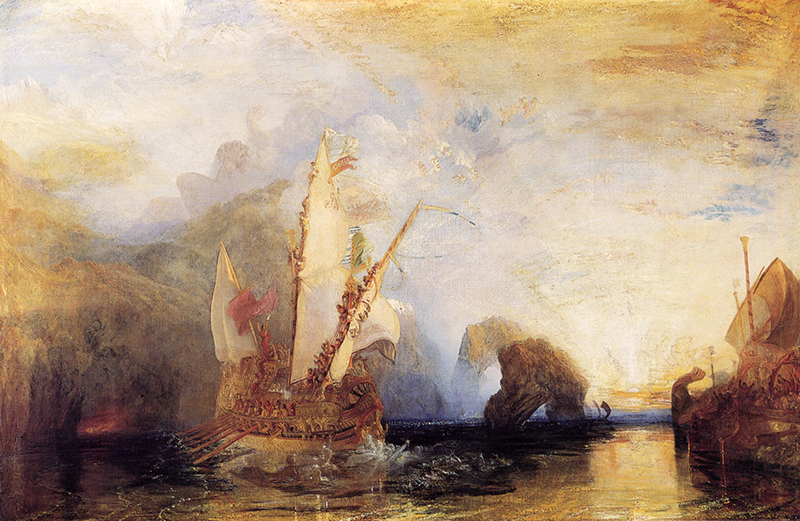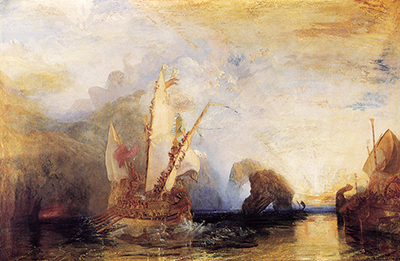This remarkable work of art, created in 1829 by Joseph Mallard William Turner, is a fantastical seascape in oil paint on canvas.
Ulysses Deriding Polyphemus is Turner's interpretation of a scene from the classic mystical Greek legend Odyssey, by Homer.
This large painting, of over two metres in width, portrays a violent scene in which Ulysses and his crew are making a hasty retreat from the island of the blinded Cyclops Polyphemus.
Ulysses is shown standing on his galley, deriding Polyphemus whom he has recently blinded, by displaying two large flags on the mast and rigging.
The orange flag bore the Greek word for 'nobody', which was the name Ulysses had given Polyphemus as his own. The other flag carries the scene of the Trojan Horse.
The incapacitated, man-eating giant is enraged that Ulysses and his crew have escaped from his cave after tricking him. He is faintly seen through the cloud on the left of the picture, hurling huge boulders at their ship.
The forces of nature have also been invoked, through the divine intervention of Neptune to bring a raging storm upon Ulysses and his men.
The whole picture has a dreamlike, ethereal quality: Ulysses, the figures of his crew, the nymphs riding the bow-wave crests, Apollo's horses in the rising sun, and Polyphemus, are suggested at and barely visible, rather than clearly outlined.
As with a lot of Turner's artwork, this is done to draw the viewer into the picture and stimulate the imagination.
JMW Turner, who was born in 1775, the son of wigmaker and barber, William Turner and his wife Mary, has been described as a classical narrative painter unmatched by his contemporary landscape rivals, John Constable and Thomas Girtin.
Ulysses Deriding Polyphemus is a painting in the romantic style, popular in the early nineteenth century.
A sketchbook of Turner's, dated 1807, contained a rough drawing of this subject, but it wasn't until 1829 that his creation was exhibited at the Royal Academy of Arts. Other paintings by Turner include; The Fighting Temeraire, The Slave Ship, Chichester Canal, The Battle of Trafalgar, and Fishermen at sea. Turner died in 1851.
The National Gallery in London acquired Ulysses Deriding Polyphemus at Turner's bequest in 1856, but it is not currently on display.





